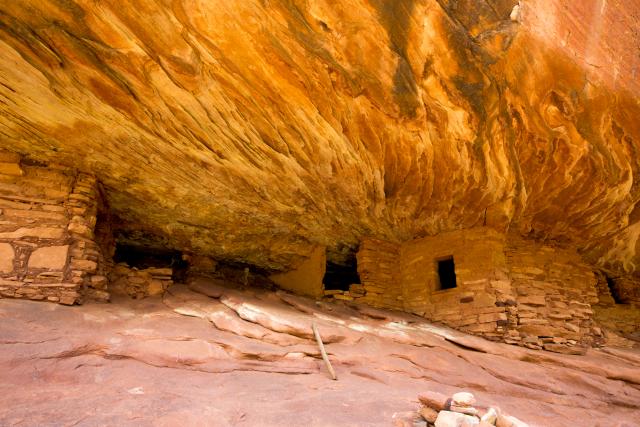BLM, USDA Forest Service issue proposed plan for Bears Ears National Monument
Organization:
BLM Office:
Media Contact:
MONTICELLO, Utah — Today, the Bureau of Land Management (BLM) and U.S. Department of Agriculture Forest Service issued a final environmental impact statement and proposed plan to manage and protect Bears Ears National Monument, one of the richest cultural landscapes in the United States, covering 1.36 million acres of public land in southeastern Utah. The proposed plan, if approved, would ensure lasting protections for the monument’s cultural and natural resources, including ancestral cliff dwellings and culturally significant landscapes, while providing continued opportunities for outdoor recreation such as hiking, camping, and hunting.
The plan incorporates Tribal input, feedback from cooperators, stakeholders, and the public, and is informed by the best available science, including Indigenous Knowledge, to ensure balanced use and protection of important resources. The Presidential Proclamation establishing the monument called for Tribal co-stewardship of the monument and established the Bears Ears Commission, comprised of representatives from five Tribes whose ancestral homelands are in part encompassed by the monument.
“Through collaboration and coordination with the USDA Forest Service, Bears Ears Commission, Tribal Nations, partners, local communities, stakeholders, and the public, we have proposed great steps to protect and preserve Bears Ears National Monument,” said BLM Utah State Director Greg Sheehan. “The proposed plan would ensure that opportunities for recreation, livestock grazing, and other appropriate and compatible uses continue well into the future.”
“The Bureau of Land Management and our many partners have provided essential insights in determining the management direction for Bears Ears National Monument,” said Forest Supervisor of the Manti-La Sal National Forest Barbara Van Alstine. “These efforts will serve current and future generations who access Bears Ears in all its diverse uses.”
"Bears Ears is integral to our ceremonies, traditions, and identity as Tribal Peoples. Co-stewarding this sacred landscape with our agency counterparts ensures we can continue passing down our cultures and lifeways,” said The Bears Ears Commission, recognizing the value of co-stewardship between federal agencies and Tribes. “We hope the invitation to return to our ancestral homelands as collaborative managers will commence a much-needed collective healing process. This Proposed Resource Management Plan represents the Tribes’ deep engagement with, and commitment to, the first national monument established at the request of five Tribal Nations and the first to formally adopt Traditional Indigenous Knowledge as a guiding principle in the enduring management framework for the monument."
The BLM and Forest Service opened a public comment period for the draft resource management plan for the Monument in March 2024. During the comment period, BLM and Forest Service held seven public meetings; two advisory committee meetings; received, reviewed, and addressed nearly 19,000 public comments; and continued to engage with local stakeholders and cooperators. The agencies also worked closely with the five Tribes of the Bears Ears Commission – the Hopi Tribe, Navajo Nation, Ute Mountain Ute Tribe, Ute Indian Tribe of the Uintah and Ouray Reservation, and the Pueblo of Zuni – whose ancestral lands are included in the monument and who maintain historic and cultural connections to the lands the BLM and Forest Service now manage.
In addition to the protection of cultural resources, the proposed plan ensures appropriate existing uses—including cattle grazing, recreation, and traditional gathering of firewood and plants—will continue. The plan recognizes the Monument’s role as a place of recreation for hikers, backpackers, climbers, and rafters, and as a place of solace and respite for visitors.
A Notice of Availability will publish in tomorrow’s Federal Register to begin a 30-day protest period and a 60-day Governor’s Consistency Review. The Forest Service is following BLM’s protest procedures. The protest period ends Nov. 4, 2024.
Following the protest resolution and governor’s consistency review response periods, the BLM will issue a Record of Decision and approved Resource Management Plan, and the Forest Service will issue a Record of Decision amending the 1986 Manti-La Sal National Forest Land and Resource Management Plan.
Those who previously participated in the planning process and have an interest that is (or may be) adversely affected by the proposed plan may file a plan protest electronically via the BLM National NEPA Register (preferred); or delivered to: BLM Director, Attention: Protest Coordinator (HQ210), Denver Federal Center, Building 40 (Door W-4), Lakewood, CO 80215.
For additional information, please contact Jill Stephenson at 435-259-2100.
Follow the Canyon Country District on Facebook @BLMMoab
Follow BLM Utah on Twitter, Facebook and Flickr @BLMUtah
Follow BLM Utah’s Instagram @utahpubliclands
The BLM manages about 245 million acres of public land located primarily in 12 western states, including Alaska, on behalf of the American people. The BLM also administers 700 million acres of sub-surface mineral estate throughout the nation. Our mission is to sustain the health, diversity, and productivity of America’s public lands for the use and enjoyment of present and future generations.

